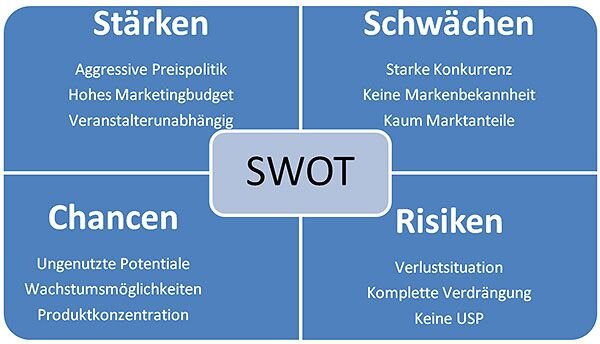SWOT
The SWOT analysis (Strengths, Weaknesses, Opportunities, and Threats) is a strategic tool for systematically evaluating the strengths, weaknesses, opportunities, and threats of a company, project, or idea.
Organisation
-
Duration
Long (more than 1 hour)
-
Complexity
Simple
-
Group size
1 to 15 persons
This activity is suitable online.
Description Long
The SWOT analysis is a well-established strategic tool that helps companies, teams, or individuals analyse their situation in a structured manner. Developed in the 1960s by Albert Humphrey at Stanford University, the method is used to identify internal strengths and weaknesses, as well as external opportunities and threats. It provides a clear assessment of areas for improvement and helps to derive sound strategies.
The four categories are:
- Strengths: Internal factors that provide an advantage (e.g. expertise, resources, brand awareness).
- Weaknesses: Internal factors that need improvement (e.g. lack of market presence, limited financial resources).
- Opportunities: External factors that offer potential for growth or improvement (e.g. market trends, new technologies).
- Threats: External risks that pose challenges (e.g. new competitors, economic uncertainties).
Illustration

Preparation
- Prepare a small version of a SWOT analysis.
- Ensure that there is enough space in the room.
Execution
- Appoint a facilitator who can listen well and knows how to guide a group without straying from the topic.
- For large groups, assign an assistant to help with the facilitation. The analysis and discussions can be recorded on a flipchart or similar.
- Introduce the SWOT method. You can use simple questions such as: "Where are we now? And where do we want to go?"
- Depending on the time available, participants should briefly introduce themselves before being split into groups of three to ten people.
- Each group selects a facilitator who will be responsible for recording the analysis. A blackboard or similar is needed for this.
- Each group should spend 20 to 30 minutes gathering strengths, weaknesses, opportunities, and threats related to the topic. Everything is allowed.
- Remind participants to collect as many ideas as possible, as the evaluation will come later.
- Comments on the organisation can help generate new ideas.
- Once a list is created, it should be narrowed down to the ten most important points.
- In the next step, the groups come together, and the generated lists are merged onto a flipchart or a blackboard.
- Ensure that the SWOT order is followed or prioritise according to factors such as the most dangerous weakness or the greatest opportunity.
- Move from group to group or invite everyone to contribute their ideas.
- Depending on the time available:
- Agree on the most important points in each category.
- Link the analysis to the vision, mission, and goals.
- Develop plans and strategies.
- If necessary, a written summary of the analysis can be made for future use.
Hints from experience
- When evaluating the analysis, opportunities within weaknesses and threats can also be identified.
- If different stakeholder groups are participating in the analysis, ensure they are well distributed across the groups.
Tools list
- Pencils, board markers
- Flipchart or Whiteboard
- Bulletin board
References
Ctb.ku.edu. Section 14. SWOT Analysis: Strengths, Weaknesses, Opportunities, and Threats. Retrieved 6 August 2015, from http://ctb.ku.edu/en/table-of-contents/assessment/assessing-community-needs-and-resources/swot-analysis/main
Humphrey, A. (2005). SWOT analysis for management consulting. SRI Alumni Newsletter (SRI International), 1.
Pelz, W. SWOT Analyse: Beispiele, Geschichte und Tipps zur Umsetzung. Retrieved from, http://www.wpelz.de/ress/swot.pdf
SWOT Analysis Activity. Retrieved from http://www.nwlink.com/~donclark/leader/SWOT.html
SWOT Analyse im Online Marketing: http://www.e2marketing.de/allgemein/swot-analyse-im-online-marketing